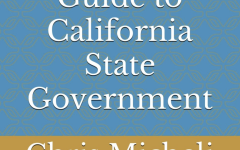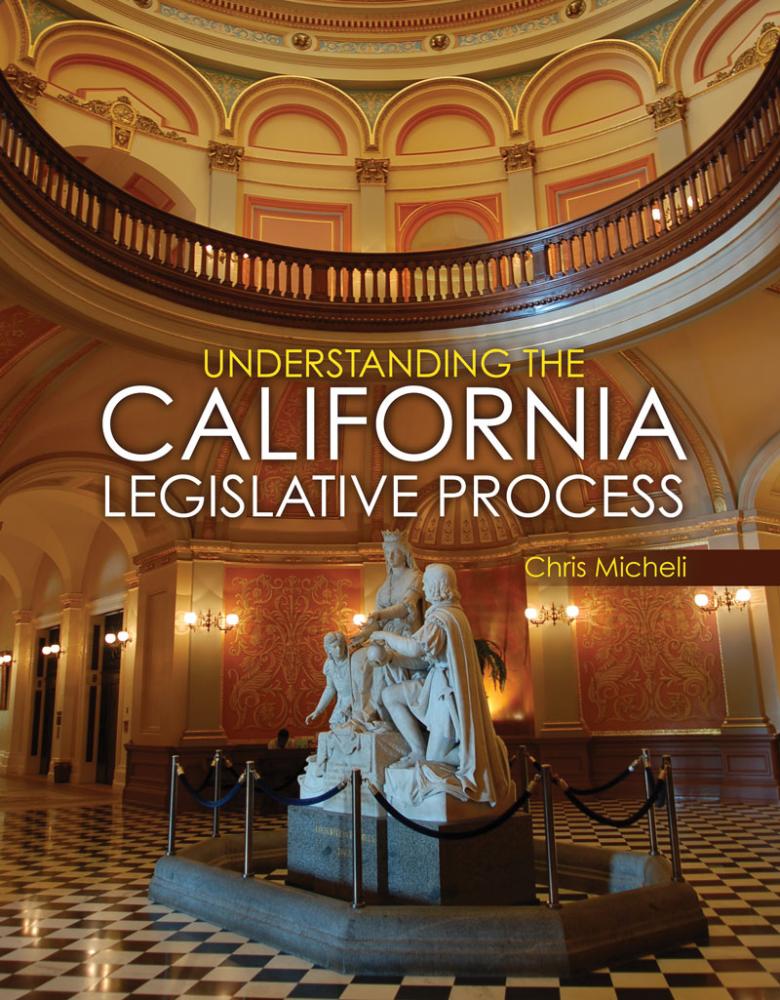
California State Government Guidebook Published
The book can be used by can be used by practitioners, students, and the general public to understand the three branches of state government
By Katy Grimes, June 7, 2024 2:55 am
California Globe contributing author Chris Micheli has just published his latest book about the many aspects of California state government: “The Complete Practical Guide to California Government.”

“This guidebook builds on my earlier book on the same topic, and I have added many new chapters and expanded coverage by including several additional parts of state government,” Micheli said.
The book has just over 200 short chapters and uses a question-and-answer format for all of the chapters in an easy-to read writing style. Like the previous edition, this guidebook has two comprehensive glossaries of terms, and it is just over 400 pages in length.
“I hope this comprehensive practical guide can be used by practitioners, students, and the general public to understand the three branches of state government along with local governments, political and election laws, and the state Constitution,” Micheli explained.
The guidebook can be purchased in either print or ebook formats at Amazon.
The following are the contents of the bill:
Chapter Page
Section I Frequently Asked Questions – Legislative Branch 1
A The Legislature 1
1 California Legislature 1
2 Legislative Privilege 5
3 Legislative Ethics 7
4 Legislative Branch Revolving Door Limitation 9
5 Legislative Publications 11
6 Examining Legislative Records 13
7 Special Sessions 15
8 Resignations and Vacancies 18
9 “Sunrise” Process 21
10 “Sunset Review” Process 23
11 Vote Changes 24
12 Using Letters to the Daily Journal 25
13 Legislative Branch Support Agencies 26
14 Per Diem and Legislators’ Expenses 29
15 Legislative Oversight 30
16 Legislative Committees Meeting Jointly 32
17 Permissible Closed Sessions 33
18 Legislative Open Meetings Law 34
19 Electing Officers 36
20 Other Constitutional Provisions and the Legislature 38
21 Legislature Conducting Its Work 40
22 Legislative Review of State Agencies 42
23 Adjournment 43
24 Improper Influences on Legislators 44
25 Expulsion or Suspension of State Legislators 46
26 Crimes Against the Legislative Power 48
27 Gifts and Honoraria and Legislators 50
B Legislation 53
28 Finding California Laws 53
29 Legislative Measures 56
30 Placeholder Bills 57
31 Bond Measures 58
32 Gut-and-amend Bills 59
33 Timing of Appropriations Bills 60
34 “Spot Bills” 61
35 Sponsored Bills 63
36 Ballot Measures Proposed by the Legislature 64
37 Bills Having Certain Provisions 65
38 Committee Bills 66
39 Author’s Amendments 67
40 Bills 68
C Legislative Process 71
41 Legislative Process 71
42 Legislature Procedures 76
43 Convening a New Legislative Session 79
44 First Part of the Legislative Session 80
45 Middle Part of the Legislative Session 82
46 Last Part of the Legislative Session 84
47 Legislative Rules of Decorum 86
48 Bill Referrals 88
49 Legislative Committee Rules 90
50 Legislative Committee Hearings 93
51 Types of Legislative Committees 95
52 Appropriations Committees’ Actions 96
53 Informational and Oversight Hearings 97
54 Motions 99
55 Suspense Files 102
56 Bill Deadlines 104
57 Legislative Floor Actions 105
58 Phrases Heard on the Floors 107
59 Legislative Measures on Consent 108
60 Reconsideration of Bills 109
61 Items on Concurrence 110
62 End-of-Session Items 111
63 Special Orders of Business 114
64 Presiding over the State Senate 115
65 Role of Mason’s Manual 116
66 Supplemental Files 117
67 Enacting Statutes and Adopting Resolutions 118
68 Influences that Shape Legislation 121
69 Vote Requirements for Bills 123
70 Differences in Legislative Floors Procedures 124
71 Two-year Bills 126
D The Budget 127
72 Budget Process 127
73 Constitutional Rules for the State Budget 131
74 Balanced Budget Requirement 133
75 May Budget Revision 135
76 Fiscal Emergency Special Sessions 137
77 Continuous Appropriations 138
78 Budget Terminology 139
E Legislative Drafting 142
79 Bill Drafting 142
80 Parts of a Bill 146
81 Parts of a Resolution 148
82 Parts of a Constitutional Amendment 149
83 Types of Bills 151
84 Order of Bill Authors and Co-authors 153
85 Order of Enumeration 154
86 Legislative Counsel’s Digest 156
87 Digest Keys 157
88 Tax Levy Bills 158
89 “Plus Sections” in Bills 159
90 General and Special Statutes 163
91 Bill Amendments 164
92 Urgency Clause Bills 167
93 Drafting Rules for Specific Types of Bills 168
94 Effective and Operative Dates of Statutes 172
95 Single Subject Rule 174
96 Joint Rule 10.5 and Fiscal Bills 176
97 Retroactivity of Statutes 178
98 Public Right of Access Disclaimers 180
F Statutory Construction 181
99 Statutory Interpretation Principles 181
100 Courts Interpreting the Legislative Process 184
101 California Codes 189
102 Retroactive v. Prospective Legislation 192
103 Legislative History and Intent 193
104 Canons of Statutory Interpretation 194
105 Codified and Uncodified Statutes 196
Section II Frequently Asked Questions – Executive Branch 197
A The Governor 197
106 Executive Branch 197
107 Governor’s Legislative Role 199
108 Governor’s Actions on Bills 201
109 Signing Messages by Governors 203
110 Vetoed Bills 204
111 Bills Becoming Law without Governor’s Signature 205
112 Governor’s Pardon and Commutation Powers 206
113 Statutory Role in International Relations 208
114 EBRs and Gubernatorial Actions 210
115 Governor and Public Records Act 212
116 Governor’s Reorganization Plans 213
117 Governor’s Line-item Veto Authority 214
B State Agencies and Rulemaking 215
118 Administrative Agencies 215
119 State Agency Ethics Training 217
120 Legislative Delegation of Authority 218
121 Office of Administrative Law 219
122 Rulemaking Process 221
123 Regular versus Emergency Rulemaking 230
124 OAL’s Standards of Review of Regulations 232
125 OAL Disapproval Process of Regulations 234
126 Judicial Review of Regulations 235
127 Legislature’s Role in Rulemaking 236
128 Exhausting Administrative Remedies 238
129 Effective Dates of Regulations 239
130 Public Hearings under the APA 240
131 Agency Rulemaking Notifications 241
132 Underground Regulations 242
133 Economic Impact Analysis 245
134 Disapproval Process for Regulations 246
135 Bagley-Keene Open Meetings Act 247
136 Rulemaking Appeals to the Governor 249
137 Possible Influences on State Agencies 250
C Other State Constitutional Officers 251
138 California’s Other Constitutional Officers 251
139 Executive Branch Revolving Door Limit 254
140 Filling Constitutional Office Vacancies 256
141 Impeachment of State Officers 258
142 Order of Precedence 261
143 State Officers and Honoraria and Gifts 262
Section III Frequently Asked Questions – Judicial Branch 264
144 California’s Judicial Branch 264
145 Role of the Judiciary in Lawmaking 270
146 Choosing Judges in California 271
147 Separation of Powers Doctrine 272
148 Judicial Branch Support Agencies 273
Section IV Frequently Asked Questions – Election Laws 275
149 California’s Electoral System 275
150 Election Laws 277
151 Direct Democracy 280
152 Amending or Revising the state Constitution 283
153 Libel and Slander in Political Campaigns 284
154 Role of Legislative Counsel in Initiatives 285
155 Role of the AG in Initiatives 286
156 Role of the LAO in Initiatives 287
157 Ballot Titles 289
158 Ballot Arguments 290
159 Political Activities of Public Employees 292
160 Political Activities in the Workplace 294
161 Nonpartisan Races 295
162 When Elected Officials Take Office 296
163 Single Subject Rule and Initiatives 297
164 Privileges of Voters 298
165 Knowing When Initiatives Are Being Amended 299
166 Voting on a Recall Petition 300
167 What Is Subject to Referendum 302
168 Voting on a Referendum 303
Section V Frequently Asked Questions – Political Laws 303
169 Fair Political Practices Commission 303
170 Lobbying Laws 305
171 Political Laws 310
172 Placement Agents and the PRA 315
173 Behested Payments under the Political Reform Act 316
174 Lobbyist Prohibitions 317
175 Lobbyist Exemptions 319
Section VI Frequently Asked Questions – Local Government 320
176 Local Governments 320
177 Special Districts 322
178 Brown Act Open Meetings Law 323
179 Incompatible Activities 325
180 Regional Governments 327
181 Ethics Training for Local Agencies 328
Section VII Frequently Asked Questions – California Constitution 329
182 California’s Constitution 329
183 Article I – Declaration of Rights 330
184 Article II – Voting and Direct Democracy 334
185 Article III – State of California 337
186 Article IV – Legislative Branch 339
187 Article V – Executive Branch 344
188 Article VI – Judicial Branch 347
189 Article VII – Public Officers and Employees 351
190 Article IX – Education 353
191 Article X – Water 356
192 Article XI – Local Government 357
193 Article XII – Public Utilities 359
194 Article XIIIA – Tax Limitation 361
195 Article XIV – Labor Relations 362
196 Article XV – Usury 364
197 Article XVIII – Amending / Revising Constitution 365
198 Article XIX – Motor Vehicle Revenues 366
199 Article XX – Miscellaneous Subjects 368
200 Article XXI – Redistricting 370
201 Article XXII – Architectural / Engineering Services 372
202 Article XXXV – Medical Research 373
Section VIII Frequently Asked Questions – Comparing California 374
203 Comparing U.S. and California Constitutions 374
204 Comparing California Government to Other States 376
205 Comparing Judicial Branches 378
206 Comparing Executive Branches 381
207 Comparing Legislative Branches 383
Section IX Glossary of Common California Government Terms 385
Section X Glossary of Common California Judicial Branch Terms 421
- ‘Viable’ Fetuses Sold From Planned Parenthood Abortions to University of California San Diego, New Documents Show - November 24, 2024
- Legacy Media is Trying to ‘Kavanaugh’ Pete Hegseth - November 23, 2024
- Gov. Newsom Brags on His ‘Economic Blueprint’ While CA Businesses Get Hit with Higher Payroll Taxes - November 22, 2024




